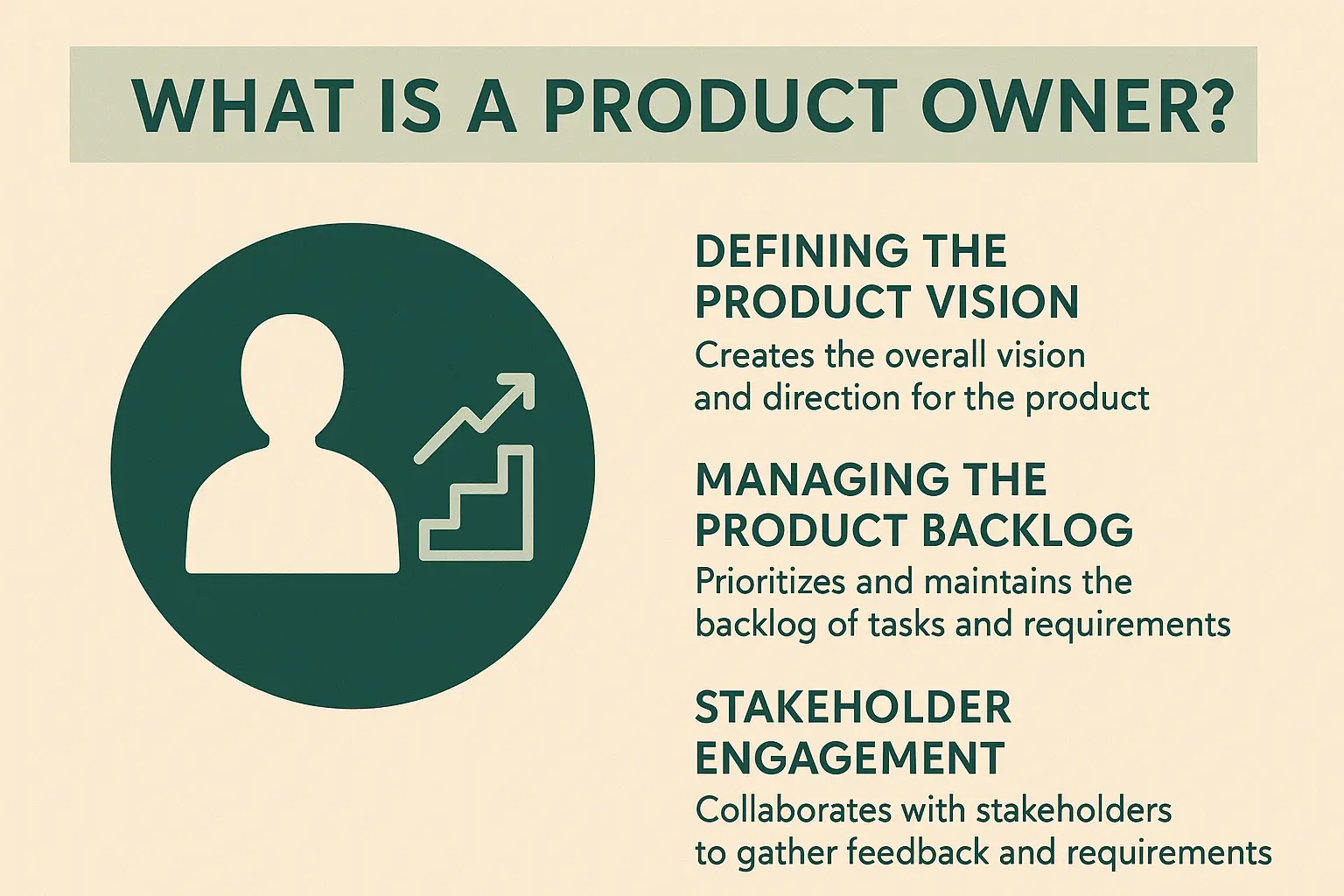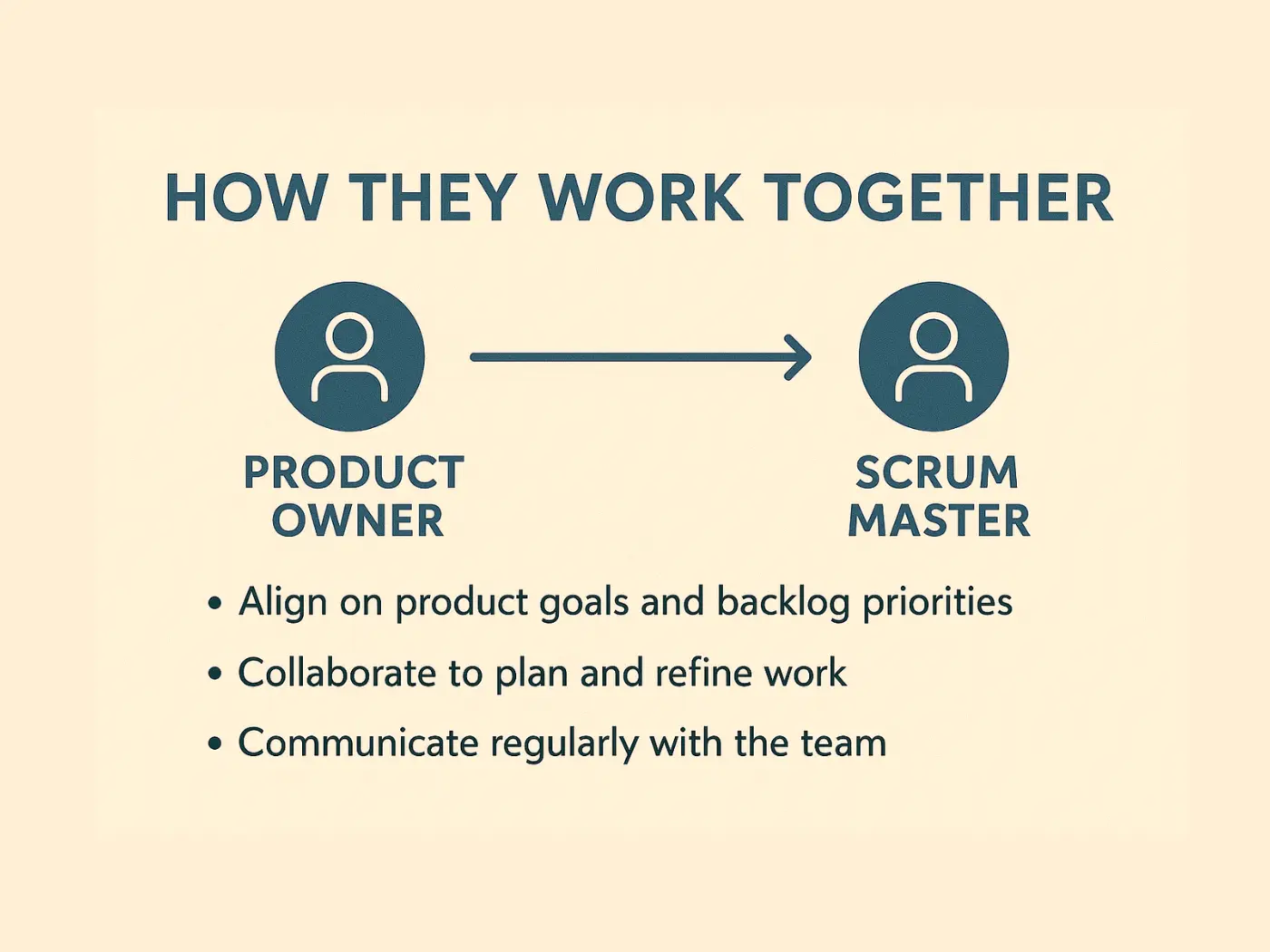In agile organizations, the terms Product Owner and Scrum Master often get mixed up. Both play leadership roles in the Scrum framework, but their responsibilities, mindset, and impact on the team are very different.
If you’re hiring for agile positions or scaling a remote development team, understanding these distinctions will help you define roles clearly and build more efficient product teams. For a deeper look into how these roles shape agile management and delivery, explore our guide on agile leadership roles.

What Is a Product Owner?
The Product Owner (PO) represents the voice of the customer. They define what the development team should build and why. Their primary responsibility is maximizing the product's value by ensuring alignment between customer needs and business objectives.
According to Atlassian's Agile Coach, the product owner role serves as the bridge between stakeholders and the development team, ensuring that the team builds features that truly meet user needs. While often compared to a product manager, the PO focuses specifically on backlog management and sprint-level prioritization. Key product owner responsibilities include translating customer needs into actionable user stories and maintaining a clear product vision throughout the development cycle.
Key responsibilities
- Define and maintain the product vision and roadmap.
- Create and prioritize items in the product backlog.
- Communicate stakeholder needs and ensure alignment with business goals.
- Accept or reject work results based on acceptance criteria.
Background & distinctive skills
Product Owners often come from business analysis, product management, marketing, or UX backgrounds — they combine strategic thinking with technological awareness and strong customer-empathy. They must translate business value into backlog items, make trade-off decisions, and keep stakeholders engaged and informed.
Research & nuance
While the classic PO definition is common, research shows that in large-scale agile projects the PO role can become much broader. For example, a study of 93 practitioners across 21 organisations found that POs in large-scale agile settings act also as communicators, travellers (across distributed teams), risk assessors, governance enablers, and even technical architect liaisons.
This means when you hire a PO — especially for a remote or cross-border team — you might want someone who can handle scaling complexity, cross-cultural communication, and varying governance demands.

What Is a Scrum Master?
The Scrum Master (SM) acts as a coach and facilitator for the scrum team. Their mission is to help everyone understand and apply Scrum effectively, guiding the team through scrum events and ensuring the scrum process runs smoothly.
As the Project Management Institute (PMI) explains, the scrum master role focuses on guiding the team's process, removing impediments, and ensuring that agile values are consistently practiced.d.
Key responsibilities
- Facilitate Scrum ceremonies (daily stand-ups, sprint planning, retrospectives).
- Remove blockers that slow down the team.
- Ensure Scrum principles are followed consistently.
- Foster a culture of continuous improvement and collaboration.
Background & distinctive skills
Scrum Masters typically come from project management, software development, agile coaching or team-lead backgrounds. They have strong communication, servant-leadership, coaching instincts and can handle process across people rather than product-vision.
What research tells us
An analysis of Scrum Masters’ activities found that most time is spent on facilitation and mentoring/coaching (≈ 69 %) while fewer hours – around 27–31 % – on negotiating with customers/POs or adapting processes.
For example:
“Scrum Masters spend most of their time on facilitation and mentoring/coaching. Many Scrum Masters seem to take a process-based perspective on Scrum, where the focus is more on the quality of the process than on the value delivered to stakeholders.”
This insight is useful when hiring: you’ll want a SM who doesn’t just run rituals, but ensures the team is delivering value and evolving in its practices.

Product Owner vs Scrum Master: Main Differences
Both roles are critical — they complement each other. The PO defines “what” to build; the SM makes sure the team knows “how” to build it efficiently and sustainably.
In practice, confusion arises because the roles have overlapping soft skills (communication, stakeholder management, agile knowledge) but differ substantially in accountability.
How They Work Together
The best agile teams have a symbiotic relationship between the Product Owner and the Scrum Master throughout the product development lifecycle:
- The PO defines the product vision and maintains the product roadmap and backlog; the SM supports the agile team to deliver it reliably and ensures the scrum process supports that vision.
- The PO manages stakeholders and prioritizes business value; the SM protects the team from scope creep, unplanned interruptions, and distractions, ensuring the scrum methodology is properly applied.
- The PO looks outward (market, users, business goals); the SM looks inward (team health, process improvement, self-organization).
- The PO and SM must communicate constantly — about backlog changes, market feedback, impediment escalations, and team capacity.
When role ambiguity occurs (e.g., a PO acting as SM or an SM making product prioritization decisions), it can undermine team effectiveness. As Mountain Goat Software emphasizes: "Scrum Masters and Product Owners perform different tasks … Each role is a full-time job on its own … A natural tension exists between Product Owner and Scrum Master roles."
This natural tension is healthy — it creates a balance where the PO can push for more value while the SM ensures the team isn't overextended. Clarity in role boundaries is essential for this dynamic to work effectively.
When this balance is clear and both roles are properly defined, agile teams can achieve faster delivery, higher morale, and better product outcomes.

Hiring the Right Role for Your Team
When hiring, many companies mistakenly look for a "hybrid" person who can fulfill both the PO role and SM responsibilities.
That's rarely effective — these roles require different mindsets, leadership skills, and metrics for success.
Hire a Product Owner when:
- You need clear product direction or a stronger connection with customers.
- The backlog is disorganized or lacks prioritization.
- You need someone with strategic skills to bridge stakeholder needs and team execution.
Hire a Scrum Master when:
- Your team struggles with coordination, blockers, or inconsistent delivery.
- You're adopting or scaling agile practices across multiple teams.
- You need a person with facilitation skills and agile certification to coach the team.
If you're unsure which profile you need first, assess your team's biggest pain points — vision and prioritization → hire a PO with strong leadership skills; process and delivery → hire a certified SM. The right skill set and certification level can make all the difference. You can also explore our guide on
how to hire remote developers to learn how to structure distributed agile teams effectively.
Why LATAM Talent Excels in Agile Roles
Many Latin American Product Owners and Scrum Masters have proven highly successful in nearshore agile teams collaborating with U.S. companies. These individuals bring a unique combination of technical expertise and business acumen, often working alongside engineers to ensure that product strategy aligns seamlessly with development execution.
Their bilingual communication, cultural affinity, and time-zone alignment make collaboration seamless — crucial factors for any company seeking to build cohesive distributed teams. LATAM professionals not only understand agile practice deeply but also adapt quickly to each organization's unique workflows and strategic priorities. Learn more about hiring software developers in South America and why the region has become a top source of agile professionals for North American teams.
They're adaptive, highly communicative, and well-versed in modern agile frameworks — ideal for distributed, fast-moving environments where both technical engineers and non-technical stakeholders need to stay aligned. Their ability to bridge the gap between strategy and execution makes them invaluable to any company scaling agile practice across remote or hybrid teams.
At BetterWay Devs, we help companies hire experienced, bilingual agile professionals across Latin America — including certified individuals who excel as Product Owners, Scrum Masters, and agile coaches.

Data & Trends You Should Know
Adding data can help strengthen your business case when presenting to leadership or revising your hiring strategy.
Agile & Scrum adoption
- According to a survey of pooled data, 86% of software-development teams reported using agile in some form, and 81% reported using some version of Scrum (including hybrid) in 2021.
- Adoption of Scrum has continued to climb: one report shows 87% of agile-focused survey respondents use Scrum in 2024.
- The biggest barriers to agile adoption: inconsistencies in processes/practices (46%), cultural clashes (43%), lack of skills & experience (42%) and absence of leadership participation (41%) — useful when assessing readiness of your organisation.
- This highlights why hiring dedicated roles (PO & SM) is important: the human element can address many of these blockers.
Role effectiveness & maturity
- Research into the distribution of leadership roles between SM and team found that in lesser-mature teams, SM retains much of the leadership, but as teams mature, leadership starts transferring to the team.
- Another study found: Scrum Masters spend ~69% of their time on facilitating events and mentoring, less time (~27%) on negotiating with business or PO. This suggests SMs should be evaluated on facilitation and team-process improvement rather than purely on product metrics.
Team structure & size
- One survey of SM duties found that two-thirds of Scrum teams had at least seven members while teams of 4-5 people were less than 20%. Also, 81% of teams ran two-week sprints.
- A typical agile team size (according to many references) is around 7 ± 2 people, which impacts the scale of PO and SM responsibilities.
Implications for hiring
- When agile adoption is high and teams are large/distributed, you’ll likely need dedicated PO and SM roles — not hybrids — to manage complexity, cross-team dependencies, backlog scale, remote coordination.
- For smaller single-team settings, some organisations may try a hybrid role (PO + SM) — but many authoritative voices caution against this.
- Metrics and KPIs: for PO you’ll measure things like product adoption, value delivered; for SM you’ll measure team health, sprint predictability, impediments resolved — recognise each role’s distinct success criteria.
Conclusion
The Product Owner ensures the team builds the right product.
The Scrum Master ensures the team builds the product right.
Understanding their complementary roles is the foundation of successful agile leadership.
Ready to hire a Product Owner or Scrum Master for your remote team?
Explore Product Owner candidates and Scrum Master candidates at BetterWay Devs — where top bilingual agile professionals from Latin America help your projects move forward efficiently.
Paula Tellez
BetterWay Devs Inbound Marketing Manager
https://www.linkedin.com/in/paula-tellez/


.png)
.png)
